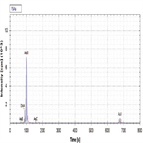Find methods for your needs
Refine by Feature
Displaying 1-5 of 5 results for Tag: IC-ICP
AN43227: Speciation of Bromine Compounds in Ozonated Drinking Water using Ion Chromatography and Inductively Coupled Plasma Mass Spectrometry
Instrument Type: ICBromate and brominated organic acids are generated by ozonation of bromide in municipal disinfection processes. The brominated compounds are toxic so compliance monitoring is required. Here four bromine species, including bromate are determined in drinking water using IC coupled to ICP-MS according to a modified U.S. EPA Method 321.8. The ions are separated by IC using a KOH gradient on an IonPac AS19 column. Then the eluting species are detected and quantified by ICP-MS down to ng/L concentrations with negligible spectral interferences using Kinetic Energy Discrimination (KED).
AN43099: IC-ICP-MS speciation analysis of As in apple juice
Instrument Type: ICInorganic and organic arsenic compounds have very different toxicities, and therefore speciation analysis is needed to assess the potential health risk posed by the food product. Here two inorganic and four organic arsenic species are determined in an apple juice sample using IC coupled to iCAP Q ICP-MS. Arsenic species are first separated by IC using an ammonium carbonate gradient on an IonPac AS7 column. Then the eluting species are detected and quantified by the ICP-MS down to ng/g concentrations. Arsenic speciation is also demonstrated in organic brown rice syrup (OBRS) in AN43126.
AN43098: Speciation analysis of Cr (III) and Cr (VI) in drinking waters using anion exchange chromatography coupled to ICP-MS
Instrument Type: ICSpeciation determinations of ionic compounds are important to determine the concentration of the more toxic form in the total elemental composition. Chromium is an industrial waste contaminant that can have serious health effects and therefore requires monitoring in municipal water systems. This method determines Chromium VI and Chromium III species in a municipal drinking water sample. The ions are separated by ion chromatography (IC) on an IonPac AG7 guard column and detected by Inductively Coupled Plasma Mass Spectrometry (ICP-MS) at ng/g. This method is further optimized in AN43175.
AN43126: IC-ICP-MS speciation analysis of As in Organic Brown Rice Syrup (OBRS)
Instrument Type: ICInorganic and organic arsenic compounds have very different toxicities, and therefore speciation analysis is needed to assess the potential health risk posed by the food product. Here two inorganic and four organic arsenic species are determined in an Organic Brown Rice Syrup (OBRS) sample using IC coupled to ICP-MS. Arsenic species are first separated by IC using an ammonium carbonate gradient on a IonPac AS7 column. Then the eluting species are detected and quantified by the ICP-MS down to ng/g concentrations. Arsenic speciation is also demonstrated in apple juice samples (AN43099).
AN43175: The Migration of Elements from Toys and Speciation of Chromium (VI) in Toy Material Using a IC-ICP-MS Solution
Instrument Type: ICSpeciation determinations of ionic compounds are important to determine the concentration of the more toxic form in the total elemental composition. Chromium compounds have brilliant hues and consequently are often used in dyes and inks however, chromium compounds are toxic. Chromium VI species is very toxic so it is monitored as an extractable in children’s toys. This method determines extractable Chromium VI (SOP EN 71-3:2012) in an ink sample separated by ion chromatography (IC) on IonPac AG7 guard column and detected by Inductively Coupled Plasma Mass Spectrometry (ICP-MS) at ng/L.





